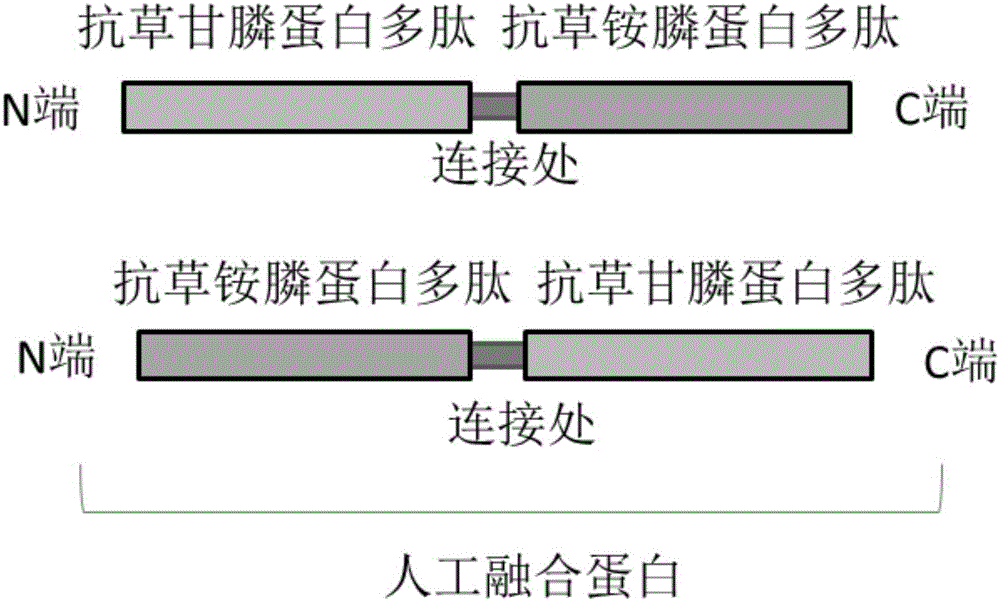Fusion gene of compound antibody type with glyphosate and glufosinate, encoded protein and application thereof
A glyphosate-resistant protein and fusion gene technology, which is applied in the fields of application, fusion polypeptide, genetic engineering, etc., can solve extensive and other problems
- Summary
- Abstract
- Description
- Claims
- Application Information
AI Technical Summary
Problems solved by technology
Method used
Image
Examples
Embodiment 1
[0027] Embodiment 1 Construction of glyphosate and glufosinate-ammonium composite resistance fusion protein expression vector
[0028]The fusion gene formed by the fusion of the glufosinate-resistant gene bar and the glyphosate-resistant gene GAT is named bar-GAT gene, and the encoded protein polypeptide sequence is shown in SEQ ID NO:3. The fusion gene formed by the fusion of glyphosate-resistant gene CP4 and glufosinate-resistant gene pat is named CP4-pat gene, and the encoded protein polypeptide sequence is shown in SEQ ID NO:4.
[0029] bar-GAT gene (nucleotide sequence as shown in the 11th-1021st base in SEQ ID NO: 1), artificially synthesized with a BamHI restriction site at the 5' end, and artificially synthesized at the 3' end terminator, and a KpnI restriction site is set, and the nucleotide sequence is shown in SEQ ID NO:1. CP4-pat gene (nucleotide sequence as shown in the 224-2164th base in SEQ ID NO: 2) and the chloroplast transit peptide CTP at the 5' end of the ...
Embodiment 2
[0038] Embodiment 2, transformation of rice
[0039] The method of obtaining transgenic rice is to adopt the existing technology (Lu Xiongbin, Gong Zuxun (1998) Life Science 10: 125-131; Liu Fan et al. (2003) Molecular Plant Breeding 1: 108-115). The mature and plump seeds of "Xiushui-134" were dehulled, and callus was induced as transformation materials. The Agrobacterium plates of the vectors pCambia1300-pUBI-bar-GAT-p35S-1174 and pCambia1300-pUBI-CP4-PAT-p35S-1174 constructed in Example 1 were respectively taken. Pick a single colony to inoculate and prepare Agrobacterium for transformation. Put the callus to be transformed into the Agrobacterium bacterium solution with an OD of about 0.6 (preparation of the Agrobacterium bacterium solution: inoculate the Agrobacterium into the medium, and cultivate it at 28°C until the OD is about 0.6; the composition of the medium: 3g / L K 2 HPO 4 , 1g / LNaH 2 PO 4 , 1g / LNH 4 Cl, 0.3g / L MgSO 4 ·7H 2 O, 0.15g / L KCl, 0.01g / L CaCl 2...
Embodiment 3
[0040] Example 3, fusion protein transgenic rice can resist glufosinate-ammonium
[0041] The T0 generation plants of the transgenic rice plants prepared by the method in Example 2 were transplanted into the greenhouse, and the herbicide resistance of the transgenic rice plants and the non-transgenic recipient control plant "Xiu Shui-134" were compared and analyzed. We obtained 128 transgenic lines (named BG) and 155 transgenic lines transgenic pCambia1300-pUBI-CP4-pat–p35S-1174 vector (named Carry out different concentrations of glufosinate-ammonium resistance determination for GC), and the resistance effect is as shown in table 1:
[0042] Table 1*:
[0043]
[0044] *Note: Table 1 shows the resistance test of rice plants sprayed with different concentrations of glufosinate-ammonium 15 days after sowing. 10 days after spraying glufosinate-ammonium, the plants with no significant difference in plant height, number of leaves and growth vigor compared with the plants spray...
PUM
 Login to View More
Login to View More Abstract
Description
Claims
Application Information
 Login to View More
Login to View More - R&D
- Intellectual Property
- Life Sciences
- Materials
- Tech Scout
- Unparalleled Data Quality
- Higher Quality Content
- 60% Fewer Hallucinations
Browse by: Latest US Patents, China's latest patents, Technical Efficacy Thesaurus, Application Domain, Technology Topic, Popular Technical Reports.
© 2025 PatSnap. All rights reserved.Legal|Privacy policy|Modern Slavery Act Transparency Statement|Sitemap|About US| Contact US: help@patsnap.com



